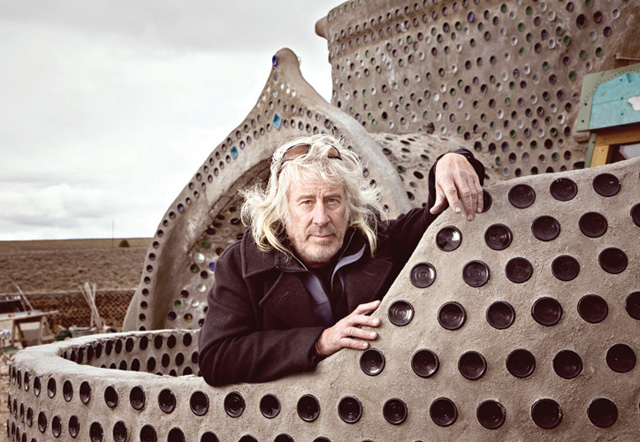Radical architect Michael Reynolds is a pioneer of biotecture, a form of off-grid building design that uses cheap, easily available, recycled materials from the local environment. Based in New Mexico, US, his ideas are being taken up all over the world, notably in the Philippines and most recently in post-earthquake Nepal
Can you tell us about your background?
I’m from Kentucky. My father was a milkman and we didn’t have much money. I went to college to study architecture and straight after went to Taos, New Mexico. My objective there was to race motocross and get an injury so I wouldn’t have to go to [fight in] Vietnam. I’ve lived in Taos ever since.

What do you like about that area?
It’s got severe climate extremes, so it’s a good place to begin working on the kinds of buildings that keep themselves warm and cool if need be. Plus there’s plenty of sun, so that’s good for solar energy. There’s not much rain, so it was a good place for us to develop a minimalist water system. We’ve ended up with homes where the infrastructure does everything for itself.
Why did you study architecture?
My dad was a builder, not by trade, but he could build houses. He built my family a house. When I was 12, I helped him add on to it and dig a basement under it. I really got into building through my father. I was always good at drawing in high school and I liked building, so it seemed natural to go into architecture at university.
You weren’t afraid to get your hands dirty at an early age then?
Right. And I think that helped me because the kind of work we do means I can’t just be an architect in an office. I have to help build because our buildings are evolving as we build them. It’s not like you make a sterile set of drawings and other people build it. I have to be involved in the builds. And I am.
Were there any buildings that made an impression on you when you were growing up?
No. Just building with my father showed me that I really like building. Architecture was, and is, kind of bullshit. It’s about money and repetition of the same kinds of things and not thinking any further about how we live on this planet. It’s a trap almost and I didn’t really like that, which is why I ended up going in this direction and we’ve ‘invented’ a new profession called biotecture.
Were there any architects you drew inspiration from at college?
To me, all architects showed me was that a lot of the famous ones were designing buildings that were beautiful but cost $40,000 per month to operate. I needed buildings to be machines that encountered the phenomena of the earth to provide the sustenance for humans. I needed the building to be a machine – a biological, environmental and physical machine. I was more into studying biology and physics to bring this about. No architects really influenced me, other than not to be an architect.
How have you developed your designs for the tropics?
Every time we do something in the tropics, we get better at it. The air moves by convection, without fans and ducts. Of course, catching water and catching power from the sun is a breeze, so it’s all about making the building comfortably cool with a lot of air movement.
How long will it be until biotecture enters the mainstream?
I think it depends how many crises hit us, like nuclear power plant meltdowns or droughts like those in California. These are not phenomena of nature. I give talks around the world all the time, but that only makes people think about biotecture. When they walk into a building and it’s not hooked up to any power, sewage or water lines and it’s comfortable, has electricity and food growing inside, great sanitation… when they see that, the building is going to speak. That’s why we go around the world building structures, as it can make things happen faster. I’m seeing a crescendo now that I haven’t seen in 45 years.
Where do you encounter the most resistance to your ideas?
In cities, for sure, as they are so dependent on infrastructure and the authorities often can’t see further than that. But even that’s changing because in places like New York after Hurricane Sandy hit, where there was no power and water, this shocked them and made them realise they are dependent. These ideas happen to be in the right place at the right time because every country has people that need something like this.
What has been your proudest achievement so far?
I’m always really excited about the thing I’m doing at that particular time.
Are you an optimist or a pessimist?
Being a pessimist doesn’t do any good. I might be a foolish optimist. I’m going to stay in a positive way about everything.
Keep reading:
“Earthship landing” – Led by renegade architect Michael Reynolds, Earthship Biotecture is trying to change the way people think about building by repurposing the world’s leftovers. They hope their current project will help rejuvenate a small Philippine village that was ravaged by typhoon Haiyan

